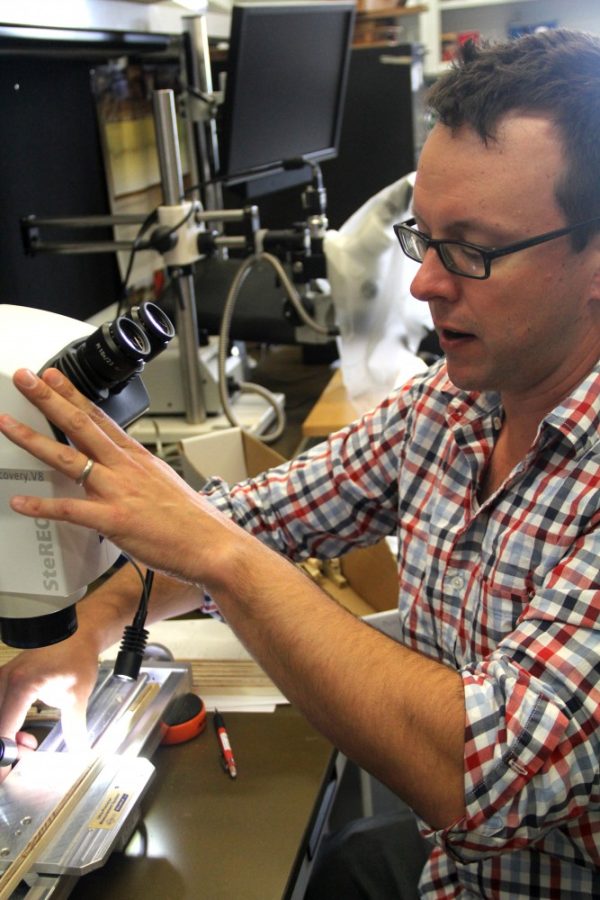When you order a cup of coffee, before adding the cream and sugar, do you ever stop to ponder the liquid inside? We don’t always think about where coffee beans come from, or how they are grown, or even where they grow.
In fact, coffee crops are experiencing major growing challenges due to the impacts of climate change. But despite the lack of public awareness, one UA researcher is currently leveraging his expertise in tree ring science to help Guatemalan growers produce our daily dose of joe.
For such a hot commodity, coffee beans actually have quite a narrow climatic range. They need a vast water supply in order to thrive. In areas of the world where rainfall is plentiful, some economies rely on the export of coffee beans in order to survive. The country of Guatemala is a good example of that. Luckily, coffee beans enjoy the lush, fertile landscape of the Guatemalan hills. But as climates change in the coming years, it will be important to prepare for alterations in moisture in many tropical areas, such as Guatemala.
RELATED: Tree rings and shipwrecks paint a portrait of hurricane activity
To make matters worse, Guatemalan coffee production hasn’t yet recovered from a devastating fungus between 2011 and 2013. Because coffee accounts for a significant portion of Guatemala’s economy, growers are concerned about what the future might hold.
However, farmers concerned about the growing climate have some reason to rejoice.
Kevin Anchukaitis is a UA associate professor in the School of Geography and Development. Anchukaitis studies paleoclimatology and dendrochronology and is currently working in Guatemala to reconstruct past climates, as well as predict what future climates in tropical areas might look like.
The advantage of using dendrochronology—dating tree ring patterns—to observe past and present climatic changes is that the right species of trees can allow annual precipitation data to be reliably traced hundreds of years into the past.
Anchukaitis said the Guatemalan fir trees he focuses on can show him whether a given season was more wet or more dry.
“This Guatemalan research is part of a larger research program looking at how climate has changed specifically both temperature and precipitation in the past,” Anchukaitis said. “Doing that is a way to understand the natural variability, and we can use that variability to understand a couple of different things about climate change.”
Although the data is quite granular, tree ring study can provide a long-term perspective. This is particularly important in paleoclimatology, a field that seeks to reconstruct the climates of many years ago. In paleoclimatology, it is important to distinguish between the natural range of behaviors of a given region and altered behavior, perhaps based on human influence.
“Understanding the natural range helps us disentangle the climate change signals from potentially normal cycles in the climate system,” Anchukaitis said. It also helps researchers understand how things might evolve in the future.
RELATED: University research team identifies the impacts of forest death on other continents
By reconstructing the climate of the past, researchers are able to more accurately pinpoint the changes human activities have contributed to the worldwide climate trend over time, alongside possible contributions in the future. Consequently, tree ring data was of specific interest to Anchukaitis, and Guatemala seemed an ideal place to start.
“Guatemala was of interest to me because it’s a frontier. It hasn’t had [dendrochronology] work done on it, and yet it hosts this incredibly vulnerable population whose economy is incredibly dependent on rain-fed agricultural methods to produce it’s coffee exports.” Anchukaitis said.
The entire region surrounding Guatemala may yet yield answers for dendrochronologists.
“The tropics are sort of the less well-studied part of dendrochronology because it’s been difficult to identify trees that put down unambiguously annual rings, which is what we count on for the raw material we study,” Anchukaitis said.
The regions closer to the equator are interesting in terms of climate change because of the large amount of rain they get already. So far, there have not been any large-scale droughts like the ones we are seeing further north in the United States.
“So, why don’t we see that yet? It probably means that the temperature increase isn’t large enough yet to push the demands for the atmosphere to have more moisture beyond what the range of the natural variability is,” Anchukaitis said.
Although climate models are predicting widespread drying, the normal rainfall variability of regions like Guatemala may take longer to feel the effects, which could be good news for commodity crops like the coffee bean.
The information from tree ring studies need not only apply to coffee. Over time, as temperatures fluctuate and soil compositions change, other crops may be affected as well. Widespread staple crops such as corn and rice may also be affected in terms of where they can be grown and how much can be produced.
Follow Rebekah Ulmer on Twitter.











